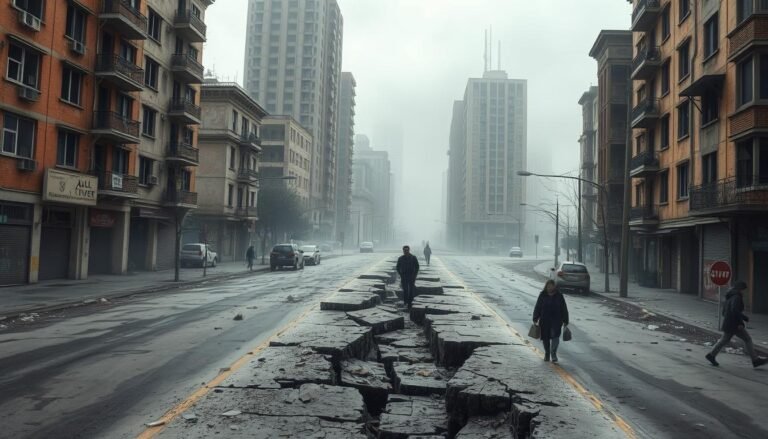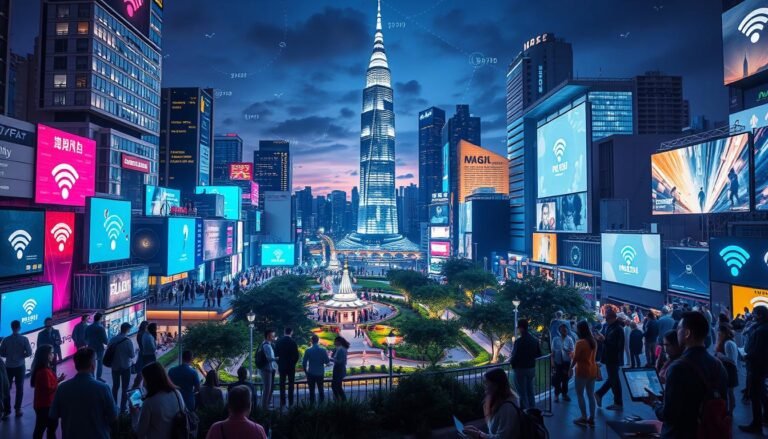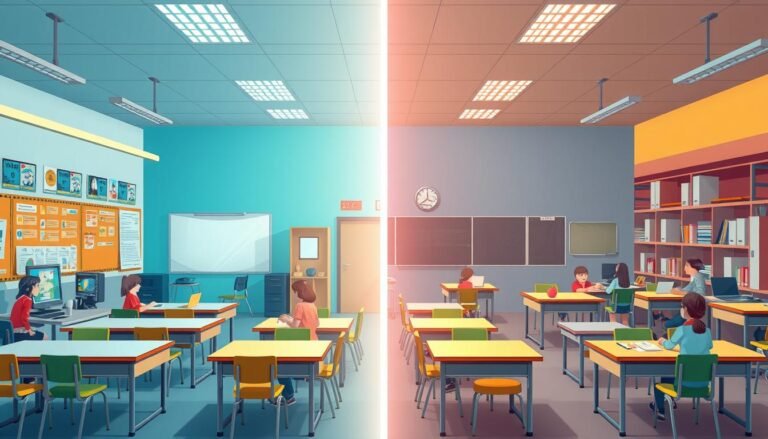The Sociology of Migration: Causes and Consequences
Why do millions of people leave their homes to explore the world? The study of migration through sociology is intriguing. It shows us the many reasons people move, from seeking better jobs to escaping political issues.
Recent surveys show that EU citizens worry a lot about migration. But many don’t know much about it. This highlights the need to understand why people move and its effects on countries.
Push-pull factors are key in deciding to migrate. These can be economic troubles or natural disasters pushing people away. On the other hand, good job opportunities and political stability pull people to certain places. This creates diverse communities around the world.
Research by Joakim Ruist at the University of Gothenburg shows migration is complex. He found that migrants vary greatly, from skilled workers to those fleeing war. This diversity demands a more detailed look at how to manage migration and integrate newcomers.
Key Takeaways
- Migration is a top concern for EU citizens, but many lack information
- Push-pull factors are key drivers of human movement
- Migrants form diverse groups with varying skills and backgrounds
- Economic, social, and political factors influence migration patterns
- Understanding migration is crucial for effective policy-making
- Diaspora communities play a significant role in shaping societies
Understanding Human Migration: An Overview
Human migration changes our world, affecting cultures, economies, and societies. It’s the movement of people from one place to another for many reasons. Let’s look at the main parts of migration and its effects.
Defining Migration in Geographical Context
Migration in geography means people moving over different distances. It can be a short move within a building or a long journey across continents. The reasons and distances people move help us understand the types of migration.
Four Major Forms of Migration
There are many types of migration, each with its own features:
- Internal displacement: People moving within their country because of disasters or unrest
- Asylum seeking: People leaving their country to escape persecution
- Economic migration: People moving for better jobs and living conditions
- Environmental migration: Moving due to natural disasters or climate change
The Role of Push and Pull Factors
Push and pull factors affect migration. Push factors push people away from their homes. Pull factors draw them to new places. Knowing these factors helps us understand why people migrate and its effects.
| Push Factors | Pull Factors |
|---|---|
| Lack of services | Better employment opportunities |
| Safety issues | Improved social services |
| Environmental problems | Political stability |
| Economic hardship | Higher quality of life |
These factors greatly influence migration patterns. They affect both the places people leave and the places they go to. The balance between push and pull factors leads to changes in culture and society.
Classification of Migration Types
Migration patterns show how people move across borders for many reasons. These include economic chances and environmental issues. Let’s look at the different types of migration and their effects on the world.
Migration can be split into different types based on distance, time, and reasons. Moves within a country are different from moving to another one. Some moves are short-term, while others last forever. People move for many reasons, like choice or because they have to.
| Migration Type | Description | Example |
|---|---|---|
| Rural to Urban | Movement from rural areas to cities | Farmers seeking industrial jobs in cities |
| International | Crossing national borders | Indian professionals moving to Western countries |
| Forced | Involuntary relocation | Refugees fleeing conflict zones |
| Voluntary | Chosen relocation | Business executives relocating for career advancement |
Transnationalism is big in today’s migration. Migrants keep strong links with their home countries but also fit into new ones. This is seen in the big money sent back by Indian migrants to places like Punjab, Kerala, and Tamil Nadu.
The United Nations says in 2020, 281 million people were counted as migrants, making up 3.6% of the world’s people. Young folks are more likely to move for school or work. These moves mix cultures, helping people understand and respect each other more.
The Sociology of Migration: Causes and Consequences
Migration changes societies deeply, driven by many factors. It’s important to understand these factors to see how human movement affects society.
Economic Factors Driving Migration
People often move for economic reasons. Job opportunities and business prospects pull them to new places. In India, 10.22% move for jobs, and 0.96% for business.
Better wages and career growth push people to move. This leads to brain drain in some areas.
Social and Cultural Motivations
Social ties and cultural dreams also push people to move. Marriage is a big reason, making up 49.35% of moves in India. Education motivates 1.77% to relocate.
These moves bring cultural exchange and diversity. But, they can also make integration hard.
Political and Environmental Catalysts
Political instability and environmental changes force people to leave their homes. These reasons aren’t as common as others, but they can cause big movements. Climate change is making people move, which is a growing issue.
The study of migration shows us many factors push and pull people. Economic and social reasons, along with political and environmental changes, shape migration. Knowing these forces helps us make better policies for migration.
Push Factors: Reasons People Leave Their Homes
The refugee crisis and border control policies are linked to push factors. These push people to leave their homes. They make life hard in their countries, pushing them to look for better chances elsewhere.
Economic struggles are a big reason people move. In 2019, there were about 169 million migrant workers around the world. Most of them were in high-income countries, showing how economic differences drive migration.
People also leave because of safety concerns and political instability. In 2022, the EU gave protection to 384,245 asylum seekers. Most came from Syria, Afghanistan, and Venezuela, showing how war and persecution push people to migrate.
Environmental issues are also a big factor. By 2050, there could be 25 million to one billion environmental migrants. This shows how climate change can force people to leave their homes.
- Lack of services
- High crime rates
- Crop failures
- Droughts and floods
- War and conflict
These push factors differ by region and can change over time. They affect how people move and where they go. Knowing these factors helps us make better border policies and tackle the refugee crisis.
| Push Factor | Example | Impact |
|---|---|---|
| Economic | Low wages in Mexico | Migration to the US |
| Political | Conflict in Syria | Refugee influx to EU |
| Environmental | East African drought (2011) | Mass displacement |
| Social | Religious persecution | Huguenot migration |
Pull Factors: Attractions of Destination Countries
Understanding why people move to other countries is key. Destination countries draw people with their charms. This shapes the makeup of diaspora communities and affects global migration.
Economic Opportunities and Career Advancement
Job opportunities are a big reason for migration. The United States is a top choice, with about 51 million international migrants. Its strong economy and varied job market draw skilled workers and laborers.
Quality of Life and Social Benefits
Many countries offer better living and social systems. These include top-notch healthcare, education, and welfare. In 2020, migrants sent $702 billion back to their home countries, showing how their lives have improved.
Political Stability and Safety
A safe place is a big draw for migrants. Countries with stable governments and low crime rates get more immigrants. This lets diaspora communities grow and blend into their new surroundings.
| Pull Factor | Example | Impact on Migration |
|---|---|---|
| Job Opportunities | U.S. tech industry | Attracts skilled professionals |
| Social Benefits | European healthcare systems | Draws families seeking better care |
| Political Stability | Canada’s government | Appeals to those fleeing unrest |
These pull factors combine to create complex immigration patterns. They shape our global society and influence where diaspora communities form and grow.
Economic Consequences of Migration
Migration has both good and bad effects on the economy of countries around the world. One big plus is remittances. These money transfers help grow the economy and cut poverty in the home countries. They also make life better for families back home.
But, there’s a downside too. Brain drain is a big issue for developing countries. When skilled people leave, it can lead to a lack of skills and slow down economic growth. This loss of talent often helps the countries where they move to more than their home countries.
Forced migration brings its own set of economic problems. Refugees often find it hard to get jobs in their new places. This puts a strain on local services and buildings. Despite this, studies show that forced migration doesn’t usually lead to more job losses or lower wages in the countries they move to.
| Economic Impact | Sending Countries | Receiving Countries |
|---|---|---|
| Positive | Increased incomes, poverty reduction | Increased production, productivity gains |
| Negative | Skill shortages, brain drain | Strain on public services, integration challenges |
To make migration work better for everyone, we need better data and more support for countries. This will help make policies that protect migrants and benefit everyone involved. It’s a way to deal with the economic effects of people moving from one place to another.
Social and Cultural Impact of Migration
Migration changes societies deeply, affecting both the places people leave and the places they go to. It brings big changes to cultural life and social setups.
Cultural Diversity and Assimilation
When people move, they bring their traditions, customs, and beliefs with them. This makes the places they go to more diverse culturally. Diaspora communities form, keeping parts of their culture while fitting into new places. How well they blend in can vary, depending on cultural similarities and social tensions.
Challenges of Integration and Discrimination
Migrants often find it hard to fit into their new homes. Language, social norms, and new systems can make it tough. Sadly, many face discrimination, due to fear, misunderstanding, or prejudice.
Effects on Social Structures and Communities
Migration changes social structures in both the countries people leave and the ones they go to. In the countries they leave, families may be split, changing support systems. In the new countries, the arrival of new people can put a strain on services but also brings new skills and views. Communities change, sometimes becoming more enriched culturally, other times facing social tensions.
- Migration introduces new markets and products
- It can lead to a loss of cultural norms for migrants
- Cultural clashes may occur due to differing values
- Social integration challenges persist in many countries
The effects of migration on society and culture are complex and wide-reaching. While it brings challenges, it also offers chances for growth, learning, and making societies more diverse and dynamic.
Demographic Shifts and Population Dynamics
Immigration patterns change the world’s population. By 2011 and 2012, the world reached 7 billion people, showing fast growth. This change moves people from one place to another, changing populations.
Fertility and death rates are key to understanding population growth. These rates differ greatly around the world. For example, Afghanistan has higher rates than Sweden and the U.S.
Transnationalism changes how people live together. Moving people across borders changes age, sex, and culture. This is seen in population pyramids, which look different in each country.
| Region | Population 2005 | Projected 2050 | Growth Rate |
|---|---|---|---|
| Global South | 5.3 billion | 7.9 billion | 49% |
| Global North | 1.22 billion | 1.25 billion | 2.5% |
| Asia | 3.94 billion | 5.27 billion | 34% |
| Africa | 0.92 billion | 2.0 billion | 117% |
These changes bring challenges for social services, jobs, and communities. As people move and grow, countries need to update their policies. This helps keep things stable and meet new needs.
Political Implications and Policy Challenges
The refugee crisis and border control policies are big challenges for countries around the world. Today, 65.6 million people are forced to leave their homes. This situation makes it hard for countries to balance their duties to help people and keep their borders safe.
This mix of political and social issues needs thoughtful solutions. It’s a complex problem that requires careful thought and new ideas.
Border Control and International Relations
Border control affects how countries work together. When countries close their borders, they can upset their neighbors. For instance, the U.S. is dealing with about 11 million undocumented immigrants, which is 3.4 percent of its people.
This shows the need for smart ways to manage borders. These strategies must think about both keeping people safe and helping those in need.
Asylum Seekers and Refugee Policies
Many people are seeking asylum in Europe, causing a lot of debate. A study looked at 18,000 people from 15 European countries. It suggested giving refugees to countries based on how much they can handle could be fairer.
But, making this happen is hard because of different political views and limited resources.
Integration and Citizenship Issues
Helping migrants fit into a new country is key to keeping society together. Where refugees live can affect their health and happiness. In Sweden, those living in poor areas were more likely to get Type 2 diabetes.
But, in the U.S., children of those eligible for the Deferred Action for Childhood Arrivals program were less stressed and happier. This shows that welcoming policies can make a big difference.
Finding a way to balance safety, helping those in need, and making sure everyone fits in is a big challenge for countries dealing with migration.
Environmental Migration: A Growing Concern
Environmental migration is becoming a big reason for people moving. Climate change is making extreme weather events more common, which could force millions to leave their homes. Experts think between 25 million to 1 billion people might have to move by 2050 because of this.
There are many reasons why people move because of the environment. Slow changes like droughts and changes in rainfall, and sudden disasters, can make people move to find new ways to make a living or because they have to. Most of the time, people move within their own country because it’s cheaper and easier.
Studies show that moving is often a way for families to spread out risks. Different environmental issues can cause different types of migration:
- Temporary displacement
- Relocation
- Long-term circular patterns
- Indefinite migration
In 1992, the International Organization for Migration said that environmental damage was already causing a lot of migration. They thought climate change would make it worse. And it has, as environmental factors are now a big part of why people move around the world.
It’s important for leaders to understand how the environment affects migration. While there’s no single theory on this topic, new studies combine different ideas. They look at how families and their resources, and the environment around them, affect migration. This gives us new ways to think about this big issue.
Conclusion
The study of migration shows us a complex mix of reasons and outcomes that shape how people move around the world. Economic, social, and political factors all play a part in shaping migration patterns. In Africa, we see many people moving within the continent to find better lives and safety.
Moving to a new country can have both good and bad effects. It can fill jobs, add to cultural diversity, and increase taxes. But, it can also strain public services and cause social issues. For the countries people leave, the effects are also mixed. Remittances can help the economy, but losing skilled workers can hurt it.
For those who move, the journey can lead to a better life and safety. But, it also brings challenges like language barriers and the risk of being taken advantage of. As more people move around the world, leaders need to think carefully about these issues. It’s important to understand all sides of migration to make fair immigration policies for everyone.
Source Links
- Causes and Consequences of Global Migration
- No title found
- A theory of migration: the aspirations-capabilities framework – Comparative Migration Studies
- Human migration | Definition, Overview, & Facts
- Migration, an Overview
- What is Migration – Types, Causes & Impact
- What is Migration: Causes, Characteristics, Types and Effects
- A theory of migration: the aspirations-capabilities framework
- Exploring migration causes: why people migrate | Topics | European Parliament
- The push-pull factors of migration
- Pull Factors of Migration: Definition
- The Economic Impact of Forced Migration
- How does migration shape economic and social development?
- Consequences of Migration: Causes & Effects
- The Effects of Migration on Socio Cultural Problems & Integration
- Microsoft Word – Thematic Study 6.doc
- Demography and Population | Introduction to Sociology – Brown-Weinstock
- Sociology 43402 – Population Dynamics
- Human population growth and the demographic transition
- Social effects of group migration between developing countries – PubMed
- Re-thinking the politics of migration. On the uses and challenges of regime perspectives for migration research
- Examining the complexities of migration
- The Environmental Dimensions of Migration
- On the Origins of Environmental Migration
- Conclusion
- What are the impacts of migration?







